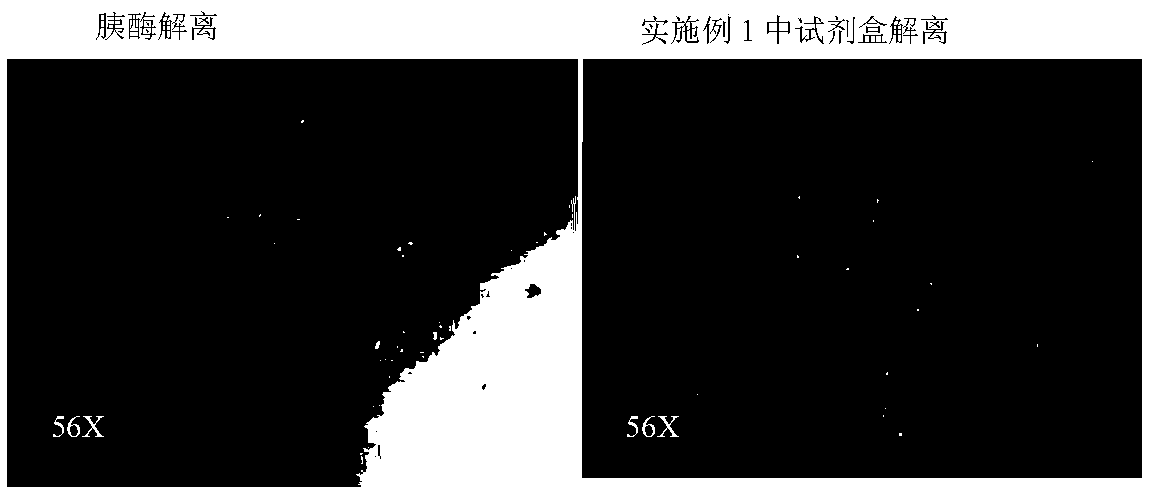Reagent kit and method for dissociating animal embryo
A kit and dissociation technology, applied in the field of animal embryo dissociation kits, can solve the problems of increased experimental cost, unfavorable research, inability to dissociate, etc., to reduce the amount of embryos used, expand the range of species, and reduce method differences. Effect
- Summary
- Abstract
- Description
- Claims
- Application Information
AI Technical Summary
Problems solved by technology
Method used
Image
Examples
Embodiment 1
[0048] Embodiment 1, the preparation of animal embryo dissociation kit
[0049] The animal embryo dissociation kits provided in this example are kit 1 and kit 2. Kit 1 is composed of the following reagents: cleaning reagent A1, pretreatment reagent B1, enzymatic solution C1, enzymatic solution D1 and enzymatic solution E1, kit 2 consists of the following reagents: cleaning reagent A2, pretreatment reagent B2, enzymatic hydrolysis solution C2, enzymatic hydrolysis solution D2 and enzymatic hydrolysis solution E2.
[0050] 1. Preparation of Kit 1
[0051] Cleaning reagent A1 is a sterile solution composed of a solvent and a solute, the solvent is water, the solute and its concentration are serum albumin 3g / 100mL, potassium dihydrogen phosphate 0.68g / 100mL, and sodium hydroxide 0.1164g / 100mL.
[0052] The pretreatment reagent B1 is a sterile solution composed of solvent and solute, the solvent is water, the solute is EDTA-2Na and sodium hydroxide for pH adjustment, the concentra...
Embodiment 2
[0062] Embodiment 2, using the kit of embodiment 1 to dissociate animal embryos
[0063] Unless otherwise stated, all the following operations were carried out on a hot stage at 38.5°C (Shanghai Weitu Photoelectric Technology Co., Ltd., WT-2010).
[0064] 1. Dissociation of porcine embryos
[0065] The dissociation of pig embryos at the cleavage stage was carried out according to the following method, and the experiment was repeated three times, wherein the pig embryos were in vivo fertilized embryos (Shenzhen Huada Ark Biotechnology Co., Ltd.):
[0066] 1. Preheat all the reagents in kit 1 in Example 1 on a hot stage at 38.5°C for more than 30 minutes;
[0067] 2. Take the embryo out of the petri dish with a glass dropper (Shenzhen Tuotai Nuo Technology Co., Ltd., short dropper (short dropper) 8*120 [branches]), wash it three times with cleaning reagent A1, and obtain the embryo;
[0068] 3. Transfer the washed embryo obtained in step 2 into the pretreatment reagent B1 wit...
PUM
| Property | Measurement | Unit |
|---|---|---|
| concentration | aaaaa | aaaaa |
Abstract
Description
Claims
Application Information
 Login to View More
Login to View More - R&D
- Intellectual Property
- Life Sciences
- Materials
- Tech Scout
- Unparalleled Data Quality
- Higher Quality Content
- 60% Fewer Hallucinations
Browse by: Latest US Patents, China's latest patents, Technical Efficacy Thesaurus, Application Domain, Technology Topic, Popular Technical Reports.
© 2025 PatSnap. All rights reserved.Legal|Privacy policy|Modern Slavery Act Transparency Statement|Sitemap|About US| Contact US: help@patsnap.com



